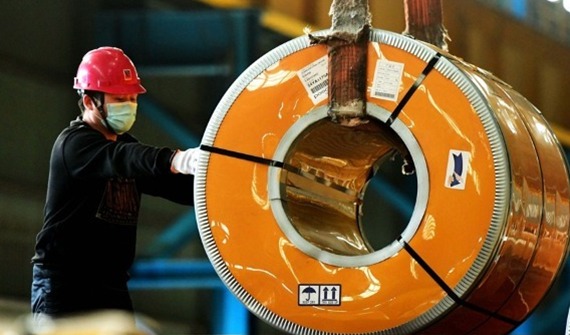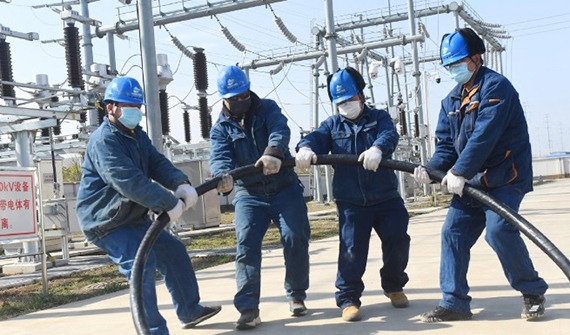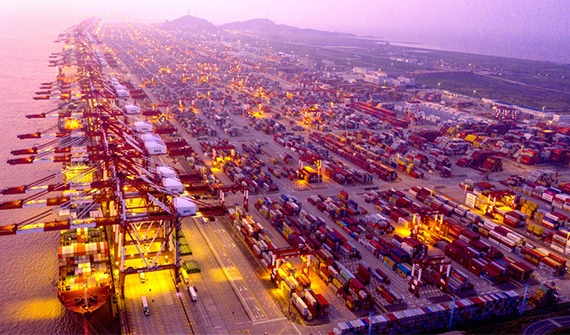editor's note
After the outbreak of the novel coronavirus, the cause of COVID-19, China has taken all necessary measures to contain the outbreak, save people’s lives, and minimize its impact on the economy.
-
Dec 31, 2019

The Wuhan Municipal Health Commission revealed 27 confirmed cases of pneumonia of unknown etiology.
Read more >>
-
Dec 31, 2019

China informed the WHO that a cluster of cases of pneumonia of unknown etiology had been detected in Wuhan.
Read more >>
-
Jan 9, 2020

Preliminary investigations pointed to a coronavirus as the probable responsible pathogen.
Read more >>
-
Jan 20, 2020

The national health authorities upgraded the management of the COVID-19 to the highest level pertaining to Class A infectious diseases.
Read more >>
-
Jan 20, 2020

Zhong Nanshan, head of a high-level expert team of the National Health Commission, said the new virus causing the pneumonia outbreak in Wuhan can spread from human to human.
Read more >>
-
Jan 23, 2020

Wuhan, capital of Hubei and epicenter of the outbreak, announced a citywide lock-down to contain the epidemic.
Read more >>
-
Jan 24, 2020

Hubei planned a new quarantine hospital, Huoshenshan, while medical workers from across China rushed to help Wuhan.
Read more >>
-
Jan 25, 2020

On the first day of the lunar new year of 2020, Xi Jinping, general secretary of the CPC Central Committee, chaired a meeting of China’s top leadership, who decided to send work groups to Hubei and other badly hit regions.
Read more >>
-
Jan 27, 2020

Premier Li Keqiang arrived in Wuhan to instruct on epidemic control and prevention.
Read more >>
-
Jan 29, 2020

All of the 31 provincial regions on the Chinese mainland had activated a Level-I public health alert, the highest level in the country.
Read more >>
-
Jan 30, 2020

Vice-Premier Sun Chunlan led a central guidance team to visit Wuhan. She met medical workers and inspected local epidemic prevention work.
Read more >>
-
Feb 2, 2020

Huoshenshan Hospital, the first hospital Wuhan built to contain the COVID-19 outbreak, started operation.
Read more >>
-
Feb 5, 2020

Wuhan launched the new virus detection laboratory Huoyan, capable of testing 10,000 samples per day.
Read more >>
-
Feb 6, 2020

Schools were asked to postpone their new semester while businesses outside Hubei province were cautioned to resume operation in an orderly manner.
Read more >>
-
Feb 8, 2020

The State Council issued a circular urging orderly resumption of production and prioritizing transportation and logistics of medical material and daily necessities.
Read more >>
-
Feb 8, 2020

Leishenshan Hospital, the second hospital Wuhan built to contain the COVID-19 outbreak, started operation.
Read more >>
-
Feb 10, 2020

President Xi Jinping inspected the Beijing Ditan Hospital, a designated institution treating the novel coronavirus pneumonia, to learn about epidemic prevention and control work in the city.
Read more >>
-
Feb 10, 2020

The Ministry of Commerce offered help to foreign companies in China to resume production, particularly with supplies of land, labor, water and power.

Read more >>
-
Feb 11, 2020

Tax authorities decided to cut taxes for certain individuals and companies affected by the COVID-19 outbreak.
Read more >>
-
Feb 12, 2020

The Ministry of Education had stepped up online employment services for college students to help relieve their job-hunting pressure.
Read more >>
-
Feb 12, 2020

Wuhan had built 11 mobile cabin hospitals offering thousands of beds to patients.
Read more >>
-
Feb 15, 2020

Plasma therapy was put into clinical practice in Wuhan.
Read more >>
-
Feb 16, 2020

The General Administration of Customs issued 10 measures to help foreign trade enterprises resume business.
Read more >>
-
Feb 18, 2020

The State Council issued a guideline asking local authorities to work out differentiated measures to fight the outbreak and resume economic and social order based on the risk level of each regional epidemic situation.
Read more >>
-
Feb 18, 2020

The top State asset regulator said over 95% of China's central State-owned enterprises in sectors of petroleum, petrochemical, communication, electricity and transportation had taken the lead in resuming production.

Read more >>
-
Feb 20, 2020

The government offered a helping hand to struggling enterprises by cutting or waiving employers' payments to various social insurance schemes.
Read more >>
-
Feb 20, 2020

The central bank cut the benchmark lending rate to spur production and mitigate the impact of the novel coronavirus outbreak.
Read more >>
-
Feb 21, 2020

Low-risk areas will fully resume their public transport services, said an official with the Ministry of Transport.
Read more >>
-
Feb 22, 2020

The top economic planner decided to cut the electricity costs of enterprises from Feb 1 to June 30.
Read more >>
-
Feb 24, 2020

China will ban the consumption of wild animals and severely crack down on the illegal wildlife trade, according to its top legislature.
Read more >>
-
Feb 25, 2020

The State Council unveiled a string of measures on employment and financial support for small and medium-sized businesses to mitigate the coronavirus’s impact on the economy.
Read more >>
-
Feb 25, 2020

The General Administration of Customs issued six measures to ensure stable trade flows and foreign investment growth in China's comprehensive bonded zones during the outbreak.

Read more >>
-
Feb 26, 2020

As of Feb 26, 13 of the 31 provincial regions on the Chinese mainland, where the epidemic had become less severe, had downgraded their public health emergency response levels.
Read more >>
-
Feb 26, 2020

China issued a set of new supportive guidelines to clarify legal issues concerning the resumption of production while controlling the epidemic.
Read more >>
-
Feb 27, 2020

China rolled out 10 measures to make it easier for people to enter and leave the country in a bid to support epidemic control and resumption of work and production.
Read more >>
-
March 1, 2020

Five central departments released a raft of measures to provisionally defer loan payments for small businesses till June 30 to tide them over the difficulties amid the epidemic.
Read more >>
-
March 2, 2020

President Xi Jinping inspected the scientific research on COVID-19 as well as the diagnosis and treatment of the disease in his visit to two institutes in Beijing.
Read more >>
-
March 3, 2020

China will further simplify approval proceedings and optimize services to encourage enterprises to resume work and production in most regions across the country.
Read more >>
-
March 4, 2020

Preferential policies including tax relief and subsidies will be adopted to reduce business risks faced by the country's aviation enterprises.
Read more >>
-
March 4, 2020

A guideline was released to protect and care for community workers who fight the epidemic at the frontline in urban and rural areas.
Read more >>
-
March 6, 2020

China’s port charges for cargo and facilities security will be cut by 20 percent from March 1 to June 30, which is expected to save enterprises and shippers 380 million yuan ($54.87 million).
Read more >>
-
March 6, 2020

China released a circular requiring efforts to meet the basic needs of vulnerable populations during the COVID-19 outbreak.
Read more >>
-
March 8, 2020

Beijing announced a series of measures for small and medium-sized enterprises to help them tide over difficulties, which is expected to reduce companies' burden by more than 50 billion yuan ($7.2 billion) this year.
Read more >>
-
March 10, 2020

President Xi Jinping inspected Wuhan and vowed to resolutely fight for a victory in the war against the novel coronavirus disease (COVID-19).
Read more >>
-
March 10, 2020

Wuhan closed its last makeshift hospital after all 15 such hospitals were cleared of patients. From Feb 5 to March 10, more than 12,000 patients have received treatment in these hospitals.
Read more >>
-
March 11, 2020

China's top economic planner urged economic regulators at all levels to further support the work resumption of foreign-funded enterprises and projects and stabilize foreign investment.
Read more >>
-
March 12, 2020

China adjusted up a key parameter in its macro-prudential management to allow domestic firms to borrow more foreign debt to ease their financing strain so that they can better resume work and production.
Read more >>
-
March 13, 2020

China outlined 19 measures to boost consumption, including improving the consumer market supply and speeding up the construction of the smart consumption ecosystem, to foster steady economic growth.
Read more >>
-
March 16, 2020

The central bank injected 550 billion yuan ($78.67 billion) of liquidity into the economy by cutting the cash amount commercial banks must reserve to stabilize market sentiment and support economic growth.
Read more >>
-
March 16, 2020

China will conduct a phased withdrawal of medical workers sent to Hubei province, its hardest-hit region during the coronavirus outbreak, as the pandemic has been brought under control in the province and the whole country.
Read more >>
-
March 18, 2020

The Chinese mainland for the first time reported zero new indigenous confirmed cases of the COVID-19.
Read more >>
-
March 23, 2020

China will strengthen financial support to its border and cross-border economic cooperation zones to create better condition for companies to resume production, as well as foster fresh momentum for foreign trade growth.
Read more >>
-
March 25, 2020

Beijing and Shanghai adopt stricter novel coronavirus prevention measures for inbound travelers, as more domestically confirmed infections have been linked to imported cases.
Read more >>
-
March 28, 2020

China temporarily suspends the entry into China by foreign nationals holding visas or residence permits from March 28, 2020, according to a statement jointly released by Chinese Foreign Ministry and the National Immigration Administration.
Read more >>
-
March 31, 2020

The Ministry of Education decided to put off the two-day gaokao to July 7 and 8 this year, the first postponement since it was resumed in 1977.
Read more >>
-
Apr 4, 2020

President Xi Jinping led other Chinese leaders to attend national mourning for martyrs who died fighting the novel coronavirus disease (COVID-19) and compatriots who lost their lives in the outbreak.
Read more >>
-
Apr 8, 2020

Wuhan, the hardest-hit area by the COVID-19 outbreak on the Chinese mainland, reopened after a 76-day lockdown.
Read more >>




